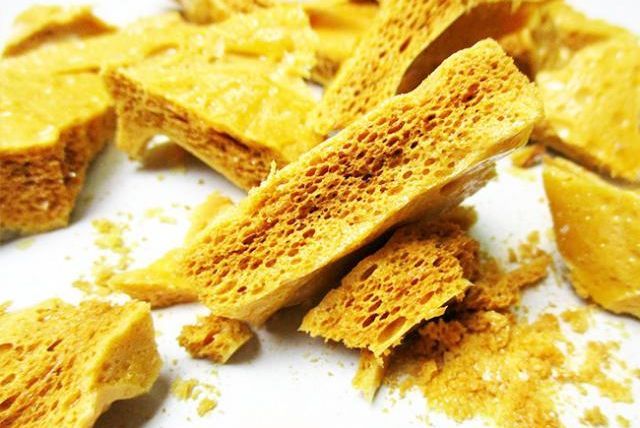Many beekeepers who want to make honeycomb honey give up quickly. Their mode of operation is adapted to the production of centrifugal love. Failures are so programmed. We show solutions.
Honeycomb honey can be made in different ways. On the one hand, it can be obtained from frames that do not require a middle wall. Here the beekeeper has to provide construction assistance and align the hive vertically. The honeycomb honey is then cut out or punched out in portions. This method is as popular as it is promising.
On the other hand, honeycomb honey can already be harvested in sales containers – so-called cassettes or “sections” – so that the beekeeper no longer has to cut it out. Such systems are more demanding in preparation and operation, but they make less effort in processing and sales.
When extracting honeycomb honey, flat or half-frames are usually used in the honey room, as these are ready to be harvested more quickly.
Making honeycomb honey: Strong colonies are important
The colonies intended for producing honeycomb honey must be very strong and have good foraging conditions. The reason: the bees expand the honey space, especially when a lot of nectar comes in. In addition to many foragers, there must be many construction bees available at the same time.
While middle walls can be expanded quickly even by less strong people, the rapid expansion of empty frames or cassettes can only be done by the most robust people with a correspondingly large number of workers. And honeycombs that are only half-developed or uncovered are poorly suited for the sale of honeycomb honey.
Therefore, the mode of operation for the production of honeycomb honey must be geared towards always having strong colonies available.
Confine colonies to a brood chamber frame
Even with powerful colonies, it can quickly happen that the construction crews in the honey room can no longer keep up with the nectar input by the foragers. To prevent the brood chamber from becoming honeyed, you should keep the colonies very close together when producing honeycomb honey. In concrete terms, this means that the colonies should narrow down to just one brood chamber frame at an early stage. The territory spends even more resources on building if the bees can not deposit honey in the brood chamber.
To avoid wild cultivation in the ground, flat ground should use. It is also essential to check the colonies for swarm cells every seven days. As people who in a swarm mood come, shut down construction activity. You should keep your people well in view and cupping gently if necessary. But it is best to balance the strengths of the people beforehand.
Making honeycomb honey: the handles around the honey chamber
Since the bee colonies not immediately prepared for intensive construction operations when they start to dress, some producers of honeycomb honey first place a honey room with central walls or expanded honeycombs on the selected colonies. The bees can then deposit the first nectar more quickly.
Even before the peak of the costume, a frame place under this honeycomb to extract honey, or the old honeycomb remove. Alternatively, incompletely removed empty shelves from the previous year can hang in the middle of the new frame. The honeycomb tongues serve as a starting aid.
Check the honey room frequently
To ensure that all the honeycombs or cassettes in a frame adequately removed, the honeycomb should check every few days during a mass costume. Poorly developed edge honeycombs can then relocate to the center of the frame. Anyone who restricts the brood on one side of the brood chamber with a bow only has to lift the honey chamber and turn it by 180 °. The former edge combs are now all above the brood nest without the beekeeper having to draw combs.
It should note that these measures are not possible with all cassettes or “sections,” as some systems for honeycomb honey production have to permanently installed in the frame. If the honeycomb in the honey room about two-thirds expanded and a lot of forage still expected, a second honey room can placed under the first.

Do not leave the combs on the colony for too long
As soon as the honeycombs in the upper honeycomb nicely developed and covered, they should remove using a bee escape. If they remain on the colony until the end of the season or until the end of a long forest, the previously white wax becomes increasingly yellowish and solid from the bees’ walking on it. The honeycomb honey is then less attractive for customers, both visually and sensually.
If another costume to expected, only partially developed honey spaces should remain on the colony. If there no more costumes, the unfinished honeycombs or cassettes can lick out by the bees by placing an empty frame between the brood and honey space. After they have lick out, they stored for the coming season and serve as a starting aid.
The alternating arrangement of frames with central walls or expanded honeycombs without main barriers or cassettes not recommended. The bees always prefer the structures with middle walls – or instead, build faster here – and pull them out into thick honeycombs, which then cause deformations on the honeycombs without the central division. If you hang the empty frames or cassettes between already capped honeycombs, you avoid this but risk solid honey, in the capped honeycombs, especially in spring.
Making honeycomb honey: processing and storage
Honeycomb honey from early costumes crystallizes in a few days to weeks due to the often high glucose content. Since crystallized honeycomb honey does not find very many enthusiasts, one should avoid the early trimmings to extract honeycomb. Or bring the honey on the market quickly, advising that it rapidly consumed. An exception is early honeycombs with a high percentage of Robinia. Due to the high fructose content in the honeycomb, this remains liquid for a very long time. Good honey for the production of honeycomb honey is also chestnut, forest, and mixed honey from the summer costume.
Anyone who does not harvest honeycomb honey directly in sales containers. Or sell it in whole. Honeycombs must first punch or cut it out of the frame. The blade of the knife should be as sharp and thin as possible to cut out pieces of the same size. It would help if you prepared a tool for measuring the portions. You can either do this with a pre-marked, small lath that place on the upper beam. Or the pattern to cut out gently pressed into the surface of the honeycomb with an appropriate gauge.
Special punches for honeycomb honey are also available in beekeeping shops. What is important here is the dimensions of the point. Which must match the inner dimensions of the frame. The cut-out honeycombs then placed on a perforated sheet or wire rack on a baking sheet. This allows the honey to drain from the cut cells.
Also read: how to start an essay.






